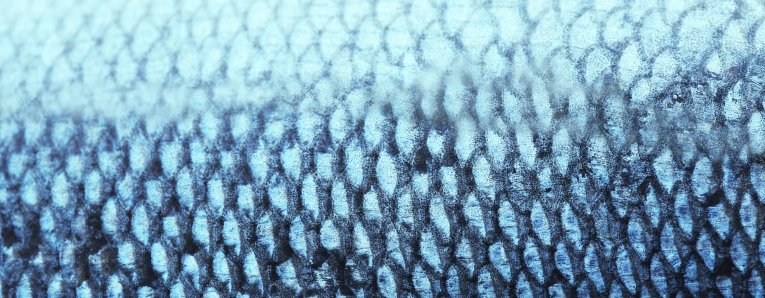Fish muscle protein
The frames and cut-offs of fish processing contain considerable amounts of protein that can be hydrolysed to obtain highly nutritional protein hydrolysates, fish silage and biologically active peptides.

- Fish protein hydrolysates are the breakdown product of fish proteins into smaller peptides of generally between 2-20 amino acids by addition of enzymes such as papain and can be in liquid or powder form. Low end uses are as fertilizers or animal feed however research into advanced uses such as functional foods and nutraceuticals are increasing.
- Fish silage is a liquid product made from whole fish or parts of fish that are liquefied by the action of enzymes in the fish in the presence of an added acid. The enzymes break down fish proteins into smaller soluble units, and the acid helps to speed up their activity while preventing bacterial spoilage.
- Bio-active peptides are isolated from fish muscle protein after enzymatic hydrolysis. These fish-derived bioactive peptides exhibit unique structural properties, amino acid composition and sequences that have a number of potential uses under investigation such as antioxidants, antihypertensive, immunomodulatory or as antimicrobial peptides. The characteristics of the purified peptides imply that they have potential for the prevention and treatment of cancer, and that they might also be useful as molecular models in anticancer drug research[2].
-
Marine osmolytes are naturally occurring organic or inorganic metabolites that help in cell volume regulation, osmotic homeostasis and protein stabilization which are fundamental to cell and organismal survival in marine life forms. Marine organisms evolved with specific osmolytes (such as methylamines eg. Trimethylamine oxide, TMAO) to protect against stressors of salinity, temperature, and hydrostatic pressure. Marine ingredients are thus prime sources of one or more of these osmolytes and thus integral to fish health in aquaculture, more so under challenging or critical production stages. Watch NOFIMA's Dr Antony Prabhu Philip for more insights.
Fish skin collagen and gelatin
Underutilised fish skin waste is a good source to isolate collagen and gelatin that can be used in food, cosmetics and biomedical industries. Collagen and gelatin are important forms of protein with unique properties and uses. Collagen is a long, fibrous structural protein with a wide range of applications from food to medical. For example, it is widely used as casings for sausages and in the medical industry for cosmetic surgery and burns surgery. Collagen is also used for unusual purposes such as in the manufacture of musical strings.

Gelatin is derived from collagen by irreversible hydrolysis and is classified as a foodstuff. Apart from its uses as a gelling agent gelatin also has biological activities as antioxidants and antihypertensive agents.[3]
Fish bone minerals
Fish bone is also a good source of collagen and gelatin but it is also an excellent source of calcium and other minerals such as phosphorus that can be used in food, feed or as a supplement. Calcium phosphates such as hydroxyapatite present in fish bone have been used for rapid bone repair after major trauma or surgery.[4]
Fish internal organ enzymes
The internal organs of fish from processing plants often go to waste but are in fact an excellent source of enzymes. The specific characteristics of fish internal organ enzymes ensure that these fish by-products are a rich source of specialised enzymes. A range of proteolytic fish enzymes are extracted which include pepsin, trypsin, chymotrypsin and collagenases as well as lipase enzymes.
Shellfish and crustacean shell derivatives
The shells of shrimps, prawns and crabs are an important category of by-products generated by marine bioprocessing plants while it is envisaged that waste from Atlantic krill will grow with the increasing popularity of krill oil. The efficient utilisation of the shells is necessary due to the volumes being generated because of increased processing as well as the slow natural degradation rate of shells.
Chitin is an important structural component of these shell wastes and is a biologically active polysaccharide that has many applications. The derivative of chitin, chitosan, has also demonstrated a number of important structural and functional properties that is desirable in a wide range of applications in the food and nutrition, biomedicine, biotechnology, agriculture and environmental protection industries. Chitin and chitosan can be further converted to oligomers that demonstrate further improved functional properties.
[1] Suarez-Jimenez, G-M., Burgos-Hernandez, A. and Ezquerra-Brauer, J-M., 2012. Bioactive Peptides and Depsipeptides with Anticancer Potential: Sources from Marine Animals, Marine Drugs, 10, pp. 963-986.
[2] Ghaly, A. E. et al., 2013. Fish processing wastes as potential source of proteins, amino acids and oils: A critical review. Microbial & Biochemical Technology, Volume 5, pp. 107-129.
[3] Kim, S.-E. & Mendis, E., 2006. Bioactivecompounds from marine processing byproducts - A review. Food Research International, Volume 39, pp. 383 -393.
[4] Mozaffarian D. (2008) Fish and n-3 fatty acids for the prevention of fatal coronary heart disease and sudden cardiac death. Am J Clin Nutr 87(6):1991S-6S
5 Muhammad A.B. Siddik, Janet Howieson, Ravi Fotedar, Gavin J. Partridge., 2020. Enzymatic fish protein hydrolysates in finfish aquaculture: a review








